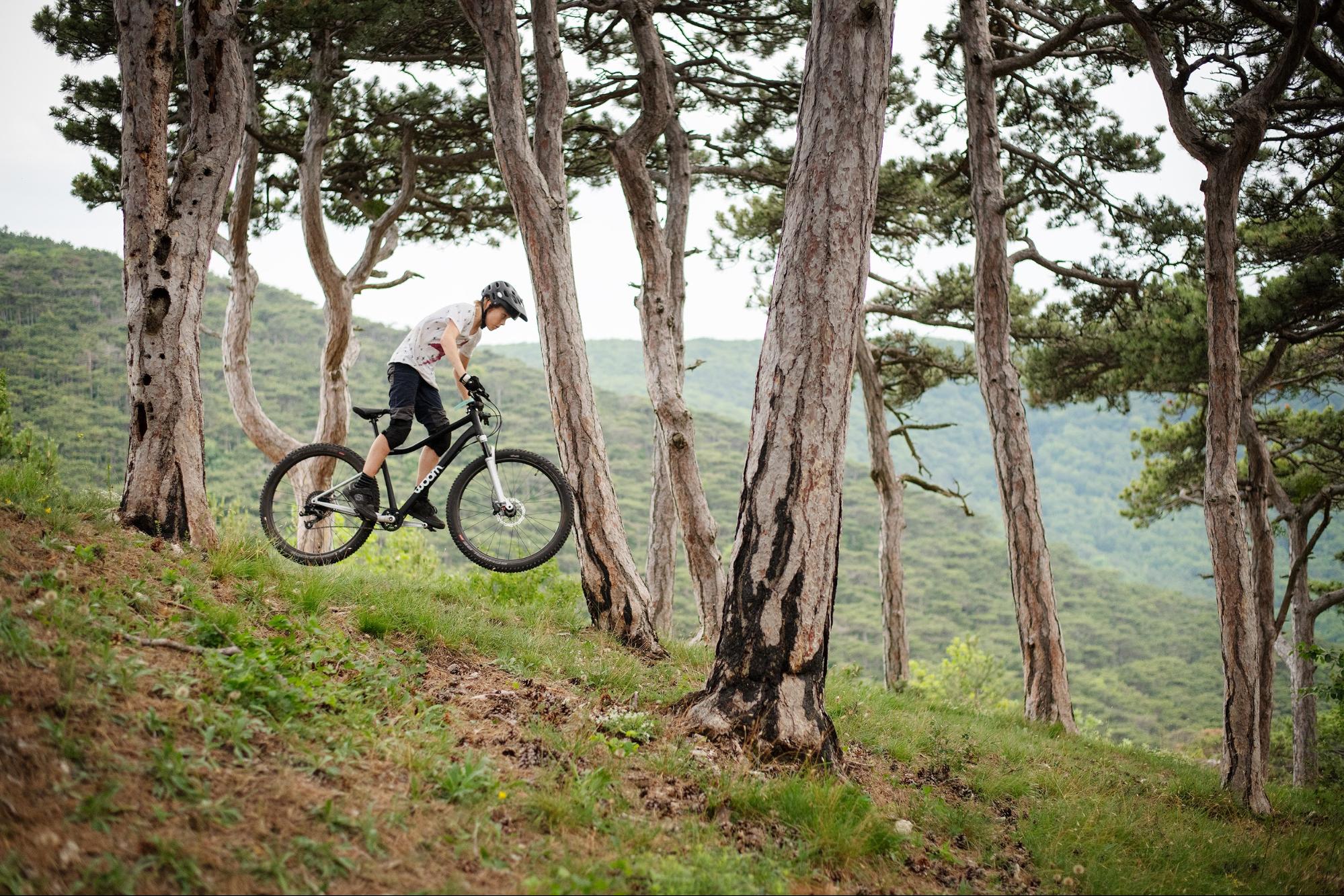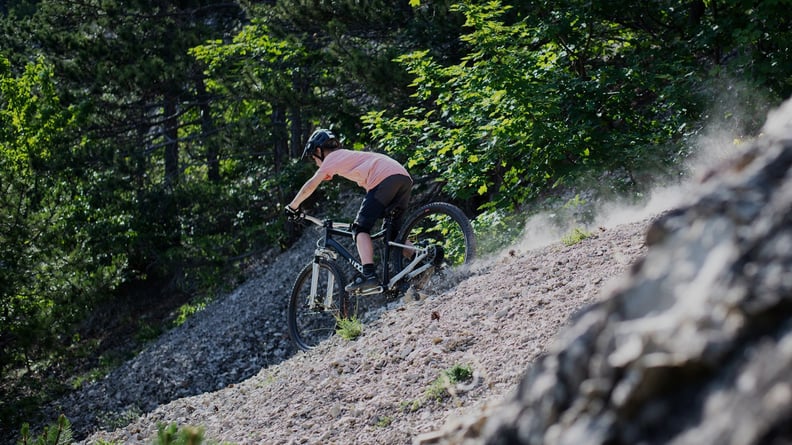A question of set-up: bike tweaks for your child to get the maximum enjoyment
TIPS & TRICKS • MOUNTAIN BIKING

The long-awaited moment! The shiny, new mountain bike is box-fresh and newly assembled. Your child can barely wait to jump on it and get pedaling. We totally get it! But a poor set-up with a saddle that’s too high or tyres that are too hard will limit the fun that even the greatest MTB in the world can provide.
Let’s begin by looking at the bars:
The brake levers
Got a good grip? Setting up brake levers correctly is really important for your child’s safety. First and foremost, the levers need to be easily reachable so that your child can rapidly come to stop if a situation requires it.
The reach of the brakes – how far the lever is positioned away from the grips – can be adjusted by turning the adjustment screw on the brake levers. The more you screw it in, the closer the levers come to the handlebar grips; loosen the screw, and the distance increases. In an ideal case, you want the levers to be virtually parallel to the bars at the moment that the brakes start to bite. Note: the levers should not pull all the way back to the grips.
The angle of the levers can also be adjusted – this involves loosening the clamp bolt (don’t unscrew it fully). What you’re aiming for here is a straight line down your child’s forearms, wrist and fingers when on the brakes, so make sure there’s no kink in their wrist. This retains a natural position for their wrist and will mean their hands won’t go to sleep while riding.
Disc brakes are a huge asset on kids mountain bikes as they require less effort and result in better braking power – kids will only need to use one or two fingers to come safely to a stop.
The gear shifters
Your child should be able to reach the gear shifter comfortably without having to strain their thumb and index finger. If they are unable to do this, loosen the screw of the shifter clamp and move the lever along the bars until it is optimally placed. Don’t forget to re-tighten it in place!
Bars and stem
The bars are an important point of contact between the bike and your child. They're vital for steering and support. The shape of the bars and their position have an influence on your child’s body position while riding, as well as how the ride feels. In recent years, trends have leaned towards wide bars with a short stem. On technical terrain this set-up lends more stability and control. Before we reveal the ideal set-up for kids mountain bikes, here’s a basic whats-what of MTB bars:
- Riser: Given their sweeping form, the bar ends on riser bars are higher than the stem. This means your kid’s hands are also higher, leading to a more upright riding position. On steep sections, this results in more control and comfort.
- Flat bars: The opposite of riser bars. The linear design keeps the front end and the cockpit low to the ground, which ensures very good grip on flat trails as the rider’s weight is further forward.
- Backsweep: By sweeping the bars back towards the rider, the distance between the saddle and the bars is reduced so your child has a shorter reach. This results in a more relaxed and ergonomic position.
So, what’s the correct position for your child’s bars and saddle, and how to find it?
It’s important that your child can reach the bars without over-stretching; their arms should have a very slight bend. As a rule of thumb, aim for an angle of roughly 45 degrees for their upper body, and have their upper arms at 90 to 100 degrees from the body.
The stem is the key piece when it comes to adjusting the height of the bars. Most stems can be fitted in two ways: negatively (with a downward slant) or positively. Our woom OFF is also equipped with this flip-flop feature.
The stem is also the piece that allows you to adjust the angle of the bars. This is done by rotating the bars a few degrees within the stem. As with the brake levers, the correct position results in a straight line from the forearm to the fingers.
It is likely to take some experimenting before your child settles into the most comfortable, correct position. And here’s where we’ll move onto the second key contact point between them and the bike:
Saddle
A comfortable riding position is crucial for a good time on the bike – in terms of both performance and pleasure.
There are two options when it comes to the saddle height:
- A lower saddle height will lend confidence to beginner riders. The ideal position allows them to comfortably place the tips of their toes onto the floor while sitting on the saddle. In the event of an unexpected obstacles, this will ensure they can stay safely upright.
- For children with more MTB experience, the advanced position will be preferable: Hold onto the bike firmly while they sit on the saddle. Turn the pedals so that you’re at the lowest point of the revolution with the cranks at six o’clock. Now position the saddle at such a height that the leg on the lowest pedal has a very slight bend in it. This will protect the knee from excessive strain while still enabling your child to put power into the pedals.
On long downhills, your child will adopt a different position – namely, stood up. Tip: Lower their saddle (dropper post-style) before starting a technical descent. This is safer and gives them more room to maneuver on the bike.
Is your child still not sitting comfortably? Here are two more elements that you can consider adjusting:
- The fore-aft position: The saddle is on rails and can be moved forwards and backwards in relation to the bars. This either extends or reduces the distance between them. With a bigger distance between the bars and saddle, your child’s riding position is more stretched-out and aero. This position is great for long rides and climbing. Note: if the saddle is too far back, their power transfer onto the pedals will suffer. But at the same time, make sure it’s not too far forward as this may strain your child’s knees. To find the optimal setting, position the saddle with the pedals parallel to the ground, and use a plumb line to check that the knee cap is aligned with the centre of the axle on the pedal that is furthest forward.
- Saddle tilt: The saddle should be positioned as evenly as possibly to avoid any imbalances in pressure. Encourage your child to give feedback as to what feels best, so try out different tilts if needed.
Important: make sure all the screws are re-tightened after these tweaks!

Tyre pressure
On the side walls of the tyres it will state the minimal and maximal tyre pressures permitted. But of course, the tyre pressure needs to account for the weight of your child and the terrain they're riding on.
So, how to decide how much pressure to put in?
Begin with a lot of tyre pressure. Send your child on a short test loop with corners and bumpy ground. After each lap, lower the tyre pressure by a small amount in both tyres. Ask your child to pay attention to how the bike grips, corners and behaves over bumps – and how it varies from lap to lap. With too little tyre pressure, the tyres are likely to wallow when cornering and feel unstable at high speeds. As soon as they can feel terrain (i.e. rocks) hitting the rims, this is a clear sign of too little pressure. The benefit of MTB tyres is that they can be ridden with low air pressure, which improves their grip, resulting in more safety when cornering. Have a play around with tyre pressure until you find a good baseline.
After tweaks and tune-ups like this, your child will be in a great position to get more out of their bike. Now, they're ready to shred!

.jpg?width=926&upsize=true&name=woom_still_and_moving_in_action_2018_345-Edit-720x480-32ef3212-c95f-4d63-b83a-d57bf7c038f6%20(1).jpg)
